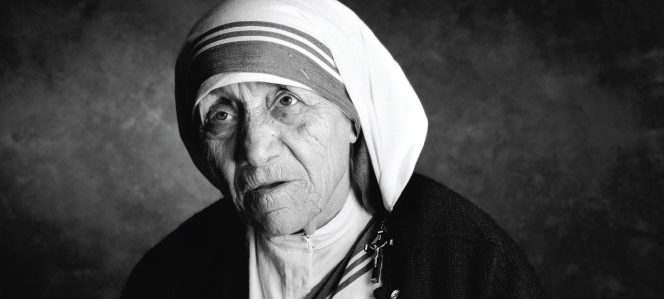The Christian Church has a long history of saints who helped the poor, sick, and dying. And like so many others Blessed Teresa of Calcutta (Mother Teresa) devoted herself to this vital work. But what sets her apart is the way she not only served people in need, but dignified them. This makes her a model for the first major theme of Catholic social teaching, the life and dignity of the human person.
From the time of her birth in 1910, Agnes Bojaxhiu (Mother Teresa) was trained to respect the dignity of others, even those society ignores. Each weeknight Agnes’ mother invited poor people into their home for dinner and conversation. She especially welcomed women in distress: old widows with no caretakers, homeless women with no roof, and unwed mothers shunned by family and friends. Agnes’ brother later commented that, “[Our mother] never allowed any of the many poor people who came to our door to leave empty handed. When we would look at her strangely, she would say, ‘Keep in mind that even those who are not our blood relatives, even if they are poor, are still our brethren.’”
It was through serving these visitors that Agnes first discovered “Jesus in his most distressing disguise.” She came to value the poor not because of what they could do or produce, not because of their job or credentials, but because they radiated the image of God. According to the Catechism of the Catholic Church, “The dignity of the human person is rooted in his creation in the image and likeness of God” (CCC 1700). Thus from the beginning until now, every man and woman bears the divine image and so bears within an inestimable dignity.
People often asked Mother Teresa why she loved the poor so much, how she could honor dignity in such difficult situations. In response, she liked to grasp their hand, slowly wiggle one finger at a time, and explain: “You-did-it-to-me.” In her mind, you could count the whole Gospel on just five fingers.
She was alluding to Matthew 25 where Jesus teaches about the final judgment. Our Lord explains that at the end of the world he will judge people by their deeds of mercy. To the kind and giving, he will say, “Come you who are blessed by my Father…For I was hungry and you gave me food, I was thirsty and you gave me drink, a stranger and you welcomed me, naked and you clothed me, ill and you cared for me, in prison and you visited me.” But his surprised listeners ask, “Lord, when did we see you hungry and feed you, or thirsty and give you a drink?” Jesus replies, “Amen, I say to you, whatever you did for one of these least brothers of mine, you did for me.”
For Mother Teresa, this passage wasn’t just a pious metaphor. It described reality. The secret to her infectious joy and boundless compassion was that in every person—every paralytic, every leper, every invalid, and every orphan—she recognized Jesus.
A Hindu gentleman once approached Mother Teresa and pointed out that while both he and Mother were doing social work, the difference was that he and his coworkers were doing it for something while Mother Teresa was doing it for someone. The compassionate nun didn’t help people simply because “it was the right thing to do.” She helped them because she knew, deep in her bones, that by serving others she was serving Jesus himself.
This insightful vision was no accident. Mother trained herself to do this each day. A young priest once prayed the Rosary with her, and when they finished, he spontaneously asked, “Mother Teresa, what is your secret?” She looked at him with a quizzical twinkle in her eye and replied, “That’s very simple: I pray.”
Like all Christians, Mother Teresa found strength and sustenance through prayer. It brought her close to Christ and helped her know him in a personal way. But she valued her favorite form of prayer—the Mass—for another reason: it helped her recognize Christ in others.
Mother and her sisters celebrated Mass every morning at 4:30am. For them, the liturgy, the Eucharist in particular, was key to living out Matthew 25—to seeing Christ in the poor. In the Eucharist, Jesus becomes present under the form of ordinary bread and wine. When the priest says the words of consecration, Christ becomes substantially present even though he’s not evident to our senses. Our faith helps us transcend sensory experience to spot the divine image in its most ordinary form.
Mother Teresa knew how crucial this was. Seeing Christ in the Eucharist enabled her to see him in the streets. “If we recognize [Jesus] under the appearance of bread,” she explained, “we will have no difficulty recognizing him in the disguise of the suffering poor.” This is why Mother Teresa could say, “I have an opportunity to be with Jesus 24 hours a day.” Whether in the chapel or the slums, the pew or the hospital, she recognized the Lord everywhere she went because she trained herself each morning at the altar.
This post was excerpted from Brandon’s latest book, Saints and Social Justice: A Guide to Changing the World. Find out more by visiting SaintsAndSocialJustice.com.
